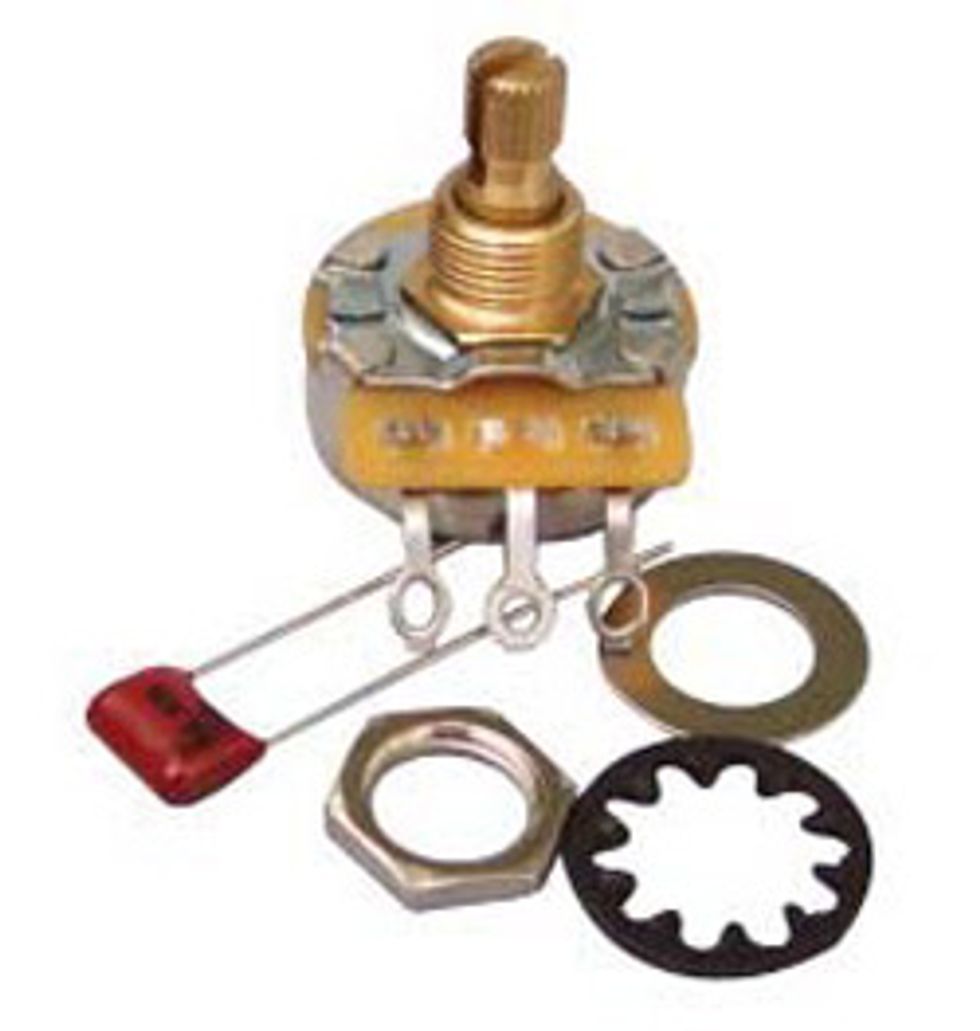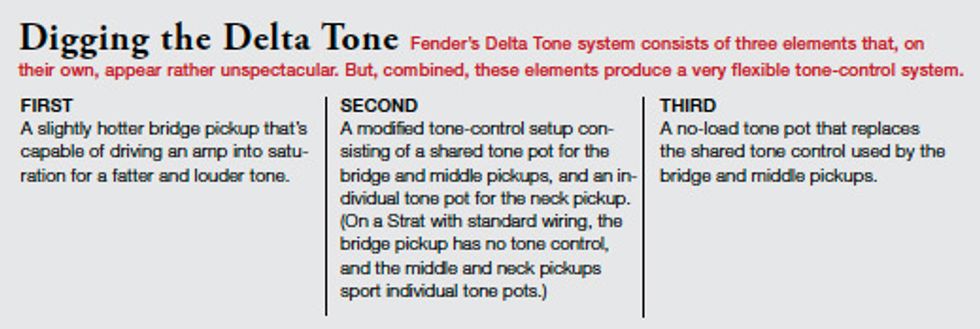 |
This month, we'll begin a two-part
series on Fender's Delta
Tone system, which includes so-called
“no-load" pots. Fender introduced
the Delta Tone in 1997, and the first
guitar to receive this new feature was
the American Standard Stratocaster.
The Delta Tone system is still in use
today. Fender called it a “system,"
because the Delta Tone is not a special
part you can add to your guitar,
but rather a combination of several
items, including a slightly hotter
bridge pickup and a modified tone
circuit (see “Digging the Delta Tone"
sidebar below for details).
Here's what Fender says about
the Delta Tone system:
The Delta Tone wiring features
a no-load tone control for the
middle and bridge pickups, great
for producing just a bit more
midrange and hotter output
from the Stratocaster. The no-load
tone pot works like a standard
tone knob from positions
1-9, but at 10, it is removed
from the wiring completely so
that you get the full, unadulterated
sonic output of your pickup.
It means more output and more
treble without using a booster
pedal or active controls.
If you want to add a Delta Tone
system to your own Strat, it's not
too hard. First, you need to choose
a replacement bridge pickup. Given
the virtually countless Strat pickups
available today, it should be easy
to find a good, slightly overwound
bridge pickup. For example,
Fender offers Custom Shop Texas
Special Strat pickups as a set (part
0992111000) or individually.
After installing the hotter bridge
pickup, you'll have to change the
configuration of the tone controls
on your Strat's 5-way pickup selector
switch, but you already know
how to do this, right? We explored
this in detail in several of my earlier
columns. In a nutshell, you only
have to add a short jumper wire
between terminals 1 and 2 on stage
2 of the 5-way switch.
The last step is to replace the
tone pot (which is now shared by
the bridge and middle pickups)
with a no-load pot. This is available
from Fender in several versions.
For a standard Strat, the 250 kΩ
version with a split shaft (part
0990832000) will work perfectly.
So what exactly is a no-load
pot? As Fender's literature hinted,
it has a detent at position 10 that
completely bypasses any filtration
via the tone capacitor and the load
of the pot itself. Unlike the TBX
tone control, which has a detent at
position 5 (the middle setting) and
gradually reduces the amount of
filtration through the capacitor, the
Delta Tone's no-load feature eliminates
it completely at the detent.
As a result, you hear more of the
direct, naked sound of the pickup.
To get an idea of this tone, you
can do a little experiment before
you decide to replace the pot. Plug
in your Strat and play a favorite
song—something you know inside
out—using the middle pickup.
Next, desolder the middle pickup
from the 5-way switch and solder
the two leads directly to the output
jack. Now play the song again.
It's a stunning difference, no?

What you now hear is the true
tone of your middle pickup in
all its sonic glory. The sound is
noticeably louder, richer, and full
of detail. Why? Because when it's
connected to the Strat's electronics,
the pickup is colored by the tone
capacitor, the load of the pots, the
wiring, and, to a small degree, even
the 5-way switch. The extent of the
loading effect depends on a guitar's
pickups and wiring, but eliminating
it is often described as “removing
a blanket from the amp." If you
like this naked pickup sound, a
no-load configuration is worth a
try. Because only the pot and tone
cap are removed from the circuit,
the result won't be exactly the same
as the direct-to-output jack experiment,
but it comes close.
Naturally, you can replace
both your Strat's tone controls
with no-load pots for even more
flexibility. But on a Strat with
standard wiring, you can't use a
no-load pot as a volume control.
If you try, you'll have a very
silent guitar with the volume
knob set to 10!
Next month, we'll take a
closer look at no-load pots and
how to convert a standard pot
into a no-load pot. Until then,
keep on modding.
Dirk Wacker lives in
Germany and is fascinated
by anything related to old
Fender guitars and amps.
He plays country, rockabilly,
and surf music in two bands,
works regularly as a session
musician for a local studio, and writes
for several guitar mags. He's also a hardcore
guitar and amp DIY-er who runs an extensive
website—singlecoil.com—on the subject.












![Rig Rundown: Russian Circles’ Mike Sullivan [2025]](https://www.premierguitar.com/media-library/youtube.jpg?id=62303631&width=1245&height=700&quality=70&coordinates=0%2C0%2C0%2C0)






